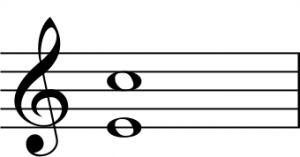Resolving Everyday Dissonance, Musical or Otherwise

Augmented Fourth
Musical dissonance occurs when two notes played simultaneously have a clash of wills. The notes just don’t play well together. The interval shown here is the classic example of a dissonant interval: an augmented fourth, a tritone.
Hundreds of years ago, dissonance was essentially prohibited in music. The perceived conflict between tones was held to be incompatible with musical expression.
But as music developed over the centuries, our ideas of dissonance changed. Sound combinations that we now take very much as a matter of course would have sent medieval listeners running for an exorcist.
In a similar way, we have come to expect a certain amount of dissonance in our daily lives. Conflict between our working and personal lives and the many demands on our time and energy create tension that can bring us to a crisis point.
Music theory teaches us how the tension created by dissonance can be eased and eliminated. Students learn about “dissonance treatment” and correct ways to resolve conflicts between notes. Wouldn’t it be wonderful if we could find a similar way to resolve the tension we encounter every day?
Tension, whether we encounter it music or elsewhere in our lives, is the outward sign of an inner conflict, a dissonance. It leaves us in a state of anxious anticipation, waiting for a resolution, for the other shoe to drop.
There are only two possible outcomes. One is for the tension to continue until a breaking point is reached. (Drop the other shoe already!) The other is for the tension to be eased by the resolution of the dissonance, a change that allows the music to move forward. (Ah…the second shoe at last.)
But how do you make the change, find the resolution that will dissipate the tension and let your energy flow again? Perhaps one of the following examples will resonate with you.
Example 1: Tension in your playing. This could be physical tension that compromises your ease of playing or inner tension that affects your enjoyment of your playing.
If the tension is left unresolved: Playing music can become a chore, lacking in musicality and freedom. Physical tension also carries the risk of pain and lasting injury.
Consider these changes: Slow down your practice so you can start a new habit of relaxing your mind and body while you play. Try some slow gentle technical exercises to refresh and calm your playing. Your mind and body might also benefit from some therapeutic massage.
Resolution: Pain-free playing and practicing that is beautiful, expressive and relaxed.
Example 2: Tension between goals and actions. Have you ever felt so busy with the things you have to do that you don’t get to the things you want to do?
If the tension is left unresolved: Your inability to find time to work toward your goals will leave you feeling like you are going in circles or frustrated with your lack of progress.
Consider these changes: Do your best to align your schedule with your priorities. At the very least, set aside some time every day, even if it’s only a few minutes, to take one step toward your goal. Even the tiniest step will keep you moving along the right path.
Resolution: You will experience a continuing sense of achievement, which will help keep you energized and motivated to do more.
Example 3: Tension between your realities and your expectations. Are you trying to play music that’s too hard? Planning to practice 3 hours a day but you have toddlers at home? New to the harp but wondering why you aren’t progressing fast enough?
If the tension is left unresolved: Prepare for a massive headache from butting your head against a wall. Unrealistic expectations will bring you stress, anxiety, and even anger.
Consider these changes: Begin by accepting that your situation is only temporary – you will make progress, your children will grow, you will over time develop the ability to play more difficult music. Give yourself the gift of understanding, and then find a teacher who can help you make a plan to achieve your goals in a reasonable timeframe. (And you may need to find a babysitter, too..)
Resolution: You will find it easier to learn and grow musically when you have a plan that works for you now and will take you into the future.
Just to drop the other shoe, here's the resolution of that tritone at the top of this post:
Resolution: Minor Sixth
What is the resolution you’re looking for?
50% Complete
Two Step
Lorem ipsum dolor sit amet, consectetur adipiscing elit, sed do eiusmod tempor incididunt ut labore et dolore magna aliqua.
